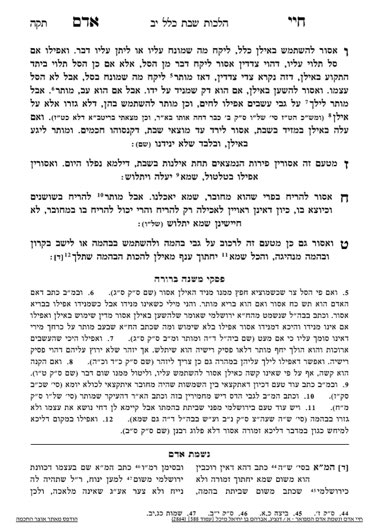Sponsorships for the upcoming Klalim, which discuss the 39 melachos of Shabbos, are available. Please contact Rabbi Reingold for more information at rabbireingold@gmail.com or 301.996.5910
We are continuing in siman 7, where we are discussing fruits which were found under a tree on Shabbos. If it is unclear whether the fruits fell before Shabbos or on Shabbos itself, they are assur to eat. We left off with the question of why are these fruits assur, if, as a safeik derabanan, we should apply the concept of safeik derabanan lekulah. One answer we learned is that we do not apply safeik derabanan lekulah on something which is a davar she’yeish lo matirim.
The Pri Megadim gives another answer, based on chazakah. He explains that we know the items to have been attached to the tree, and now we are unsure when they detached. Chazakah tells us that the status quo remains true, and the items detached from the tree later (on Shabbos itself) rather than earlier (before Shabbos). This chazakah is known as chazakah d’meikarah, chazakah based on what was originally. If the item was last seen in a certain state, it is presumed to remain in that state. Thus, if a woman is married to a kohen, she is allowed to eat terumah. When the husband goes to work, she can continue to eat terumah, and does not need to be concerned that her husband died.
Although it sounds like a gezeiras hakasuv, we live with the concept of chazakah all the time. For example, although it is obviously not a good idea to drive a car without brakes, we do not check our car’s brakes every time we drive. Halachically, we have a concept that sakanah is more chamur than issur, so if we check out tzitzis every morning, we should have to check out the car’s brakes as well. The answer is that we rely on the fact that since they have been working until now, they are probably still working. The chiddush of the Torah is that this concept of chazakah does not just apply in our everyday lives, but is a halachic reality as well.
In the above scenario, the question was if the status has changed, and the answer is to rely on chazakah d’meikarah and assume that the status did not change. A second scenario is when we know that something changed, and the question is only when did it change. In this scenario as well, we assume that it changed at the last possible moment. In other words, if the detached fruits are found under the tree on Shabbos morning, we assume they fell right before the person checked, and assume they fell on Shabbos.
The Pri Megadim uses the answer of chazakah, and not davar she’yeish lo matrim, because the concept of davar she’yeish lo matirim only applies to something which can, practically, be kept until after Shabbos. If it is something which will not last until after Shabbos, such as a delicate fruit which will rot from being in the sun all day, the rule of davar she’yeish lo matirim would not apply. Thus, the Pri Megadim gives a more comprehensive answer to explain why these fruits remain assur on Shabbos.
The concept of chazakah d’meikarah is learned from the pasuk regarding checking for tzara’as. If a person comes to the kohen to check for tzara’as, if the tzara’as spreads the person is tamei. We know whether it has spread because the person has the kohen look at it, and then returns seven days later for another check. When it comes to tzara’as on a house, the same procedure is applied. If the tzara’as spread, the kohen leaves the house and then paskens that it is tamei. The spreading must occur between the time that the cohen closes the individual or the house and when he looks at it again seven days later. One could however argue that maybe the tzara’as shrunk in the time that the kohen looked at it until he left the house, and then remained the same during the seven days of enclosure, as there is a short time lapse between when the cohen looks, and he closes the house. So how can he declare it tamei seven days later, as he does not know when the change took place. That is where chazakah tells us that it did not change until later, after he closed the house, and hence during the seven days of enclosure. . Thus the pasuk also tells us that even though the tzara’as clearly changed between the two times the kohen saw it, we assume it changed later rather than earlier.
Summary
It is assur miderabanan to take fruits which fell off a tree on Shabbos, unless one is certain that those specific fruits fell before Shabbos.
Chazakah allows us to assume the status quo until we know otherwise, and
Chazakah tells us to assume that changes occurred later rather than earlier.



